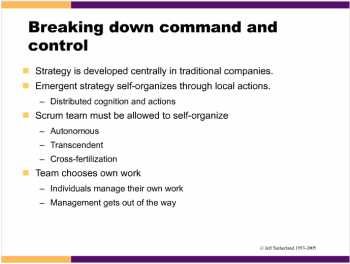|
|
Slide 17 - Comando e controle
Quebrar a estrutura de comando e controle é a parte mais difícil quando se lida com qualquer processo ágil, não apenas o Scrum. Porque – novamente, isto vem direto da Toyota – a estratégia é desenvolvida centralmente em empresas tradicionais. Mas estratégias emergentes se auto-organizam através da ação local. As pessoas na linha de frente são as que estão no campo. Na Toyota isto está nos vendedores de carros, ou nas linhas de montagem. É lá que as coisas emergem e você deve permitir a distribuição do conhecimento e a distribuição de ações para formar o produto. Assim, no contexto do Scrum, a equipe precisa ser formada de forma a permitir que ela se auto-organize. E esta é a mágica do Scrum. É ser capaz de formar um time que se auto-organize. E Takeuchi e Nonaka dizem que há três coisas que dizem a você se um time está se auto-organizando ou não. A primeira: o time é autônomo? Eles sentem-se totalmente responsáveis? Eles estão com a bola? Não há ninguém no caminho deles? Ninguém está atrapalhando eles? Transcendência. Por transcendência eles querem dizer: “cada membro do time está focado no sucesso do time, ao invés de seu próprio avanço pessoal na carreira?”. Caso isto não ocorra, o time não se auto-organizará. A terceira, polinização cruzada. Os membros mais experientes da equipe ajudam os menos experientes? Pessoas que têm alguma especialidade estão compartilhando o conhecimento com os outros? Os colegas do XP tem uma regra: a qualquer momento que alguém pedir ajuda, você tem que ajudá-lo. Você não pode dizer: “hmm, talvez em dois dias”. Você não pode dizer: “Estou muito ocupado”. Não! A regra do XP é “você ajuda” quando for solicitado. Desta forma, o XP tem uma regra que reforça a polinização cruzada. E a equipe escolhe seu próprio trabalho. Eles escolhem o quanto irão fazer. Os indivíduos na equipe escolhem que peças irão fazer. Os indivíduos na equipe auto-organizam seu próprio dia. Eles fazem isto da forma como eles pensam que será o melhor para eles. E a gerência afasta-se do caminho deles. So, breaking down the command and control structure is the hardest part of dealing with any of the agile processes, and not just Scrum. Cause typically strategy – again, this is right out of Toyota, Toyota literature, Ok? -- strategy is developed centrally in traditional companies. But emergent strategies self-organizes through local action. The people on the front lines are in the field. But Toyota ... it's in the auto dealerships, or on the assembly line. That's were things emerge and you gotta allow distributed awareness and distributed actions to form the product. So, in the context of Scrum, the Scrum team needs to be set up so it is allowed to self organize, Ok? And this is the magic of Scrum. It's to be able to set up a team that will self organize. And Takeuchi and Nonaka say there are three things that tell you whether the team is self organizing or not. First one is: is the team autonomous? Do they feel totally responsible? Do they have the ball? Is everybody out of their way? Nobody is messing with them? Ok? Transcendence. By transcendence they mean “is every member of the team focused on making the team successful, rather than their own personal career advancement?” Ok? If that is not happening the team will not self organize. And third, cross-fertilization. Are the more experienced members of the team helping the less experienced? Are people who have specialized knowledge sharing with the others? The XP folks have a rule: anytime someone asks for help, you have to help them. You can't say “well, maybe in two days”, you can't say “I'm too busy”, no! The rule on XP is “you help” when you are asked to help. So, XP has a rule that tries to enforce that cross fertilization. And the team chooses their own work. They choose how much they are going to do. The individuals on the team chooses what pieces they are going to do. The individuals on the team self organizes their own day. They do it in the order that they think it will work best for them. And management gets out of the way.
|






